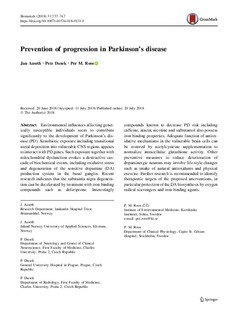| dc.contributor.author | Aaseth, Jan | |
| dc.contributor.author | Dusek, Petr | |
| dc.contributor.author | Roos, Per M. | |
| dc.date.accessioned | 2019-12-11T12:48:18Z | |
| dc.date.available | 2019-12-11T12:48:18Z | |
| dc.date.created | 2018-08-27T10:32:12Z | |
| dc.date.issued | 2018 | |
| dc.identifier.citation | Biometals. 2018, 737-747. | nb_NO |
| dc.identifier.issn | 0966-0844 | |
| dc.identifier.uri | http://hdl.handle.net/11250/2632748 | |
| dc.description.abstract | Environmental influences affecting genetically susceptible individuals seem to contribute significantly to the development of Parkinson’s disease (PD). Xenobiotic exposure including transitional metal deposition into vulnerable CNS regions appears to interact with PD genes. Such exposure together with mitochondrial dysfunction evokes a destructive cascade of biochemical events, including oxidative stress and degeneration of the sensitive dopamine (DA) production system in the basal ganglia. Recent research indicates that the substantia nigra degeneration can be decelerated by treatment with iron binding compounds such as deferiprone. Interestingly compounds known to decrease PD risk including caffeine, niacin, nicotine and salbutamol also possess iron binding properties. Adequate function of antioxidative mechanisms in the vulnerable brain cells can be restored by acetylcysteine supplementation to normalize intracellular glutathione activity. Other preventive measures to reduce deterioration of dopaminergic neurons may involve life-style changes such as intake of natural antioxidants and physical exercise. Further research is recommended to identify therapeutic targets of the proposed interventions, in particular protection of the DA biosynthesis by oxygen radical scavengers and iron binding agents. | nb_NO |
| dc.description.abstract | Prevention of progression in Parkinson’s disease | nb_NO |
| dc.language.iso | eng | nb_NO |
| dc.rights | Navngivelse-DelPåSammeVilkår 4.0 Internasjonal | * |
| dc.rights.uri | http://creativecommons.org/licenses/by-sa/4.0/deed.no | * |
| dc.title | Prevention of progression in Parkinson’s disease | nb_NO |
| dc.type | Journal article | nb_NO |
| dc.type | Peer reviewed | nb_NO |
| dc.description.version | publishedVersion | nb_NO |
| dc.rights.holder | Open Access - This article is distributed under the terms of the Creative Commons Attribution 4.0 International License (http://creativecommons.org/licenses/by/4.0/) | nb_NO |
| dc.source.pagenumber | 737-747 | nb_NO |
| dc.source.volume | 31 | nb_NO |
| dc.source.journal | Biometals | nb_NO |
| dc.source.issue | 5 | nb_NO |
| dc.identifier.doi | 10.1007/s10534-018-0131-5 | |
| dc.identifier.cristin | 1604584 | |
| cristin.unitcode | 1991,1,2,0 | |
| cristin.unitname | Avd Forskning | |
| cristin.ispublished | true | |
| cristin.fulltext | original | |
| cristin.qualitycode | 1 | |

